American Sabbatical 98: 4/21/97
Cajun Country
4/21.. Cajun Country.
The party was over Monday morning, but we were in no hurry to leave. We had eaten
red beans and rice, but hadn’t tried muffalettas, beignets, or
crawfish remoulade, so we’d have to come back. We hadn’t seen
much of the city outside the Quarter, either, but we tried to
remedy that by spiraling out from Bourbon Street.
Basin Street, the old heart of Storyville, had been renewed out
of existence, and paved over. Maybe just as well, to judge by
the map of low dives and cribs operating there when Cotton was
King. And then Sugar. It may be where jazz was born, but Dr. John
and Marie Laveau were the conjuring physician and midwife, and
their hospital has been bulldozed. But the mojo is still working
on other back streets.
We cruised around the modern sculpture gardens downtown, then
followed the last trolley line, Jackson Street, into the Garden
District. A 19th century suburb where all the noblesse built elaborate
residences, the District is another wonderland of Steamboat Gothic,
wrought-iron effacement, shaded galleries and effusive plantings.
Honeysuckle instead of horse manure scented its privy parts. Now
engulfed by greater New Orleans, this enclave is just as visually
exciting as the Quarter, and its outer fringe looks like a place
where artists might even afford to live. And ride the streetcar
to their desires.

Destrahan Bridge
|
We wanted to find our way up the river to Plantation Row, but
got lost passing the Elk’s Lodge, or was it the airport? Anyway,
we shuttled back and forth over elevated causeways looking down
into hectares of cypress swamp.. the great drowned wilderness
surrounding the Crescent City. When we eventually found our off
ramp it led up to the most astonishing bridge yet, at Destrahan.
Peggy’s first plantation house was just downriver on the north
bank, and I dropped her there, then found a prospect to view this
arching feat. |
The Owl sat on the shoulder while I climbed the levee. Topped
with a white gravel walkway, this necessary embankment looks onto
the busy ship channel of Mama M., and admires the bridge. I couldn’t
find its name. No signs. Not on the maps we had. Isn’t it strange
how monumental utilitarian sculpture becomes invisible and un-remarked?
This is another stay-suspended act of modernity. A huge one. The
two soaring towers are dark burnt sienna, a ruddy black, and are
shaped like narrow vertical rectangles standing on slightly spraddled
legs, with the suspended deck arching through them. If the towers
are square-cornered Os, the A-line stays supporting the roadway
make this the OAOA Bridge. I mouthed these syllables while I drew
the scene. Tangled swamp trees along the shore, big ships, barges,
and towboats sweeping past at hull speed, wakes rolling along
the banks. Wildflowers glimmering on the levee.

Bryce's View
My Post Sybaritic Stress Syndrome was acting up. After ignoring
the aromas for three days, I was having a full-blown noserun.
I started eating anti-histamines and acting erratic. Peggy, in
the other seat, was exhibiting the giddy symptoms of Historiosis.
(Memo #94)
Apr 21 Creole plantations (Destrehan and Laura)
Who? settlers of French (and Spanish) descent
What? distinctive manor houses on sugar and indigo and cotton
plantations
When? built in late 1700’s and early 1800’s
Where? along the Mississippi River in Louisiana
How? agricultural cash crop and slave labor fortune
Topics: plantation economy, King Cotton, indigo, sugar cane, Creole
culture
Questions: How do plantations differ from Virginia to the Carolinas
to Tennessee to Louisiana? What is Creole culture? What were the
conditions on a Mississippi River plantation? |
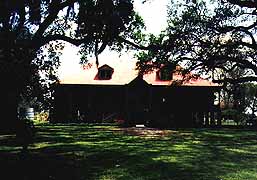
Laura in the Shade
|
The main problem for the plantation tourist in Louisiana is choice.
There are eight or ten plantation houses near New Orleans open
for day trippers and many more invite you as you drive the countryside.
Old time maps show plantations as strips all the way to Baton
Rouge. For a whole bunch of reasons I wound up seeing Destrehan
Plantation on the east bank and Laura Plantation on the west bank.
They were both windows into Louisiana plantation life and Creole
culture, very different from the plantations we have seen in Virginia
and the Carolinas.
Both houses are in the distinctive architectural style known as
RAISED CREOLE COTTAGE. This apparently combines elements of French,
Caribbean, and African buildings. Its outline is long with a low
pitch to the roof (we realize that the modern Florida-Southern
ranch house has much the same angles). The windows are all floor
to ceiling with shutters that actually shut. The house is surrounded
by a wide veranda (or gallery) and all rooms open directly onto
it. There are no inner hallways, you move from room directly into
another room (rooms are generally multi-purpose). It is a house
raised a story off the ground on brick piers. The first (brick)
floor can be simply a storage area (as it is at Laura) pretty
much open to the air or an integral part of the house and wonderfully
cool (Destrehan). The main floor is reached by small outer staircases
to the veranda. The outer appearance of a Creole plantation is
simple and airy.
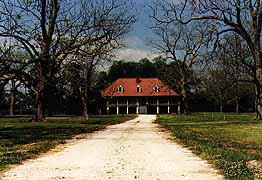
Generic Plantation
|
The Louisiana planters were cosmopolitan. They spoke only French,
sent their teenaged daughters to convent school (usually in St.
Louis) and their sons to train in a city and to Europe. The plantations
were their main money-making enterprises, but the heart of their
social life was always in New Orleans and they maintained houses
there. They would come to the plantations for the main rice season
(and some of the elderly stayed year round). New Orleans was their
base from January to April during the ball and Mardi Gras seasons.
This was also the pattern in the low country of the Carolinas,
the Georgetown area rice planters kept town houses in Charleston
(sometimes in Georgetown too). |
Both families (at Laura and Destrehan) were among the Louisiana
elite and contained lawyers and cotton merchants, politicians
and civic leaders. No one family member in either house was a
totally dominant historical figure (such as George Mason), so
the tourist hears the FAMILY history through numerous generations
and there are many good stories. There are some artifacts associated
with the families, but in both cases the houses have had other
owners . Destrehan was a club house for oil company executives
at one time. During a vacant period the sheriff foiled robbers
who were trying to make off with the house’s huge marble bath
tub.
Both houses were built by slave labor with expert craftsmanship
by “free men of color”. The latter was an important social class
in New Orleans. French law gave slaves (and women) many more rights
than in the English colonies. Apparently slaves could even own
guns to hunt for their families in French Louisiana.
The cypress for the houses was cut nearby (the trees for Laura
were 3000 years old when they were cut!) and the bricks (incredible
soft powder when you touch them) were made on the spot. Laura
was a “maison de trente” meaning it had thirty beams. The slaves
spent 11 months in the forest preparing the wood for Laura and
then actually built the house in 11 days!! |
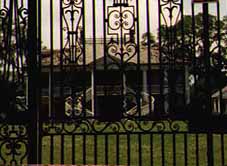
Plantation Gates
|
I was fascinated to hear at both plantations (and later at Kate
Chopin’s house) how prejudiced Creoles were against “Americans”
who were considered fairly uncouth. For example, no Creole (and
no Quebecois) uses the front door, “seule les animaux et les americains”!
(only animals and Americans do) . Laura’s most flamboyant mistress
Nanette refused to allow “Americans” into her house.
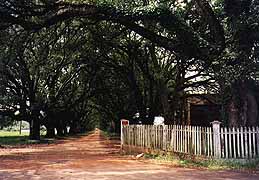
Old Plantation Drive
|
Both plantations had amazing stories. There were a number of strong
women whose actions belie the stereotype of the soft southern
lady. One mistress of Destrehan wanted the plantation to be run
by and for its slaves. This will was voided by the courts. The
colorful Nanette of Laura was killed by a cannon ball as she paced
the veranda of the house swearing at the Union gunboats threatening
it. |
DESTREHAN - Destrehan is the nearest plantation to New Orleans.
The major highway snakes through desolate delta swamp (small trees,
Spanish moss, mud) from the suburbs to a Mississippi Bridge. Destrehan
is hard by the modern levee, twelve miles from New Orleans (a
three hour boat ride in its heyday). There are huge grand live
oaks trees in the yard. The house was once a mile from the river
bank, now a few hundred yards and a levee separate them. The plantation
which ran TWO miles along the Mississippi and had 600 acres, was
the second largest producer of sugar in the area and one of the
owners worked hard to perfect the granulation process. The slave
population varied from 57 to 210 slaves.
As in Virginia, the other plantation buildings (50+) were called
“dependencies” and included a tannery, 2 hospitals, 24 double
slave cabins, a wash house etc.
The house underwent numerous renovations. One owner enclosed part
of the gallery to provide space for a grand interior staircase,
widened the house by two rooms at either end to provide more bedrooms,
added a number of Greek revival features in the mid 1800’s (wider
doors with Greek trim, and front columns). Two small “garconnieres”
are two storied separate additions across the veranda on either
side. The name describes the purpose which was to provide a separate
residential area (and billiards room) for grown sons . |
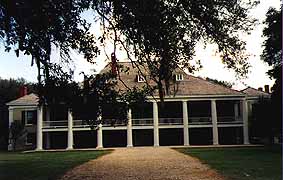
Destrahan
|
Destrehan really used its ground level where the dining room and
butler’s pantry are. On the April day I visited the reason was
obvious: the temperature dropped at least ten degrees when I entered
the brick floored rooms “under” the house. The table was set for
dessert. The grand double staircase took us to the main floor
where there is an elegant double parlor. Bedrooms open off the
parlors on either side. There is much less furniture than in a
Virginia plantation. The whole house seems rather spare and airy.
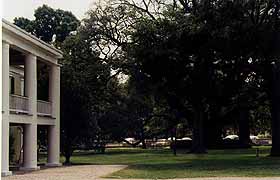
The Trees at Destrahan
|
After the Civil War the plantation was used to house 600 freedmen
who were giving training. 75-80% returned to their prewar masters
and became sharecroppers.
And Destrehan became property of an oil company
|
LAURA - Laura claims to be the place where in 1870 the Brer Rabbit
stories were recorded (in French) as the Compair Lapin tales.
Joel Chandler Harris recorded the same stories in Georgia in English.
Compair Lapin and Brer Rabbit are both an outgrowth of hare the
trickster stories brought over by slaves from Africa.
| Like Destrehan, Laura has gone through many renovations. Originally
it was designed as a “u” with the two rear wings funneling cool
air into the court between (which the guide says was an African
design). A spiteful heir chopped off one wing and moved it. The
other was moved to the center so that the house is now an atypical
“T” shape (without cooling winds). A turn of the century owner
added the gingerbread, front staircases, larger doors, a front
door. The house has not been fully furnished or restored. Wallpaper
is peeling in places. |
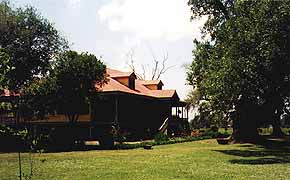
Laura
|
Laura is only a few hundred yards from the river. Oddly the 69
slave cabins were three and a half miles away from the main house.
Four that remain have been moved near to the big house.
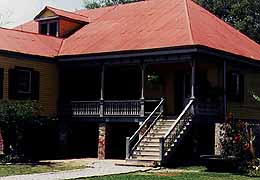
Closer in
|
Laura was run as a family COMPANY, directed by women at several
points. We heard of the family tragedies, the members dying of
yellow fever, the young daughter killed in France by an injection
intended to cure her acne. (The mother was so distraught that
she locked herself in her bedroom at Laura for the rest of her
life.) |
Laura is named after a spirited daughter of the house who lived
101 years (from the term of Abraham Lincoln to that of John F.
Kennedy)! She remembered a former slave, a chronic runaway, showing
her the scar on his forehead where her grandmother Nanette had
branded him. Laura remembered her grandmother getting ready to
sell a slave mother off and keep the son on the plantations. Laura’s
kindhearted father bought the two slaves who stayed on after the
Civil War in gratitude (at $12 a year). Laura wrote her memories
of plantation life after Gone With the Wind presented a romantic view of the old South.
| The two houses made the Creole culture extremely vivid. House
space was divided by gender with the men’s side (and bedrooms)
down river. The men’s side had a demie-porte or narrow door (too
narrow for the hoop skirts). A gentleman looking for a chamber
pot, would “look for the demie-porte”. Children (88 at Laura)
were born in an upriver (woman’s) bedroom. Dining rooms were big
because they were used for dancing. The Creole felt the Americans
didn’t know how to have fun - the Puritans allowing no liquor,
dancing, smoking. |
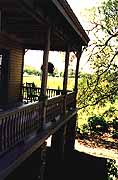
Gallery
|
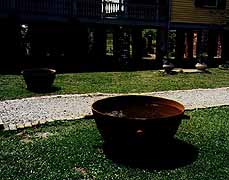
Sugar Pot
|
TRIVIA - The guides were extremely knowledgeable and kept giving
odd small facts which intrigue me but don’t always weave in well.
So.. Louisiana at one time had seven factories processing Spanish
moss (which the Creole called “Frenchman’s beard”) which was used
for mattresses. While Jello is only a hundred years old, in colonial
times a gelatin dessert was made by boiling pigs’ feet and adding
sugar and cochineal (beetles - for red color) or spinach (for
green color). Yum. The huge cisterns that collected water off
the roofs were also the breeding places for mosquitoes that caused
the yellow fever epidemics. Huge four foot tall pottery jars came
into New Orleans carrying olives and olive oil. The locals would
wash them out, bury them up to their necks and use them for cold
storage (apparently they stayed a constant 45 degrees). |

Slave Quarters at Laura
4/21.. cont.
The Owlers swivelnecked as we rose over the OAOA. Across the Mississippi, and headed
West at last. Which meant along the River Road at this point.
Every mile or so we’d pass another grand plantation house set
back from the river, with long drives lined in live oaks. To our
right, over the levee, we’d see ship superstructures twirling
their electronics as they sped past. St. Charles Parish. The drowned
woodlands all had the feathery foliage of willows, tossing in
the persistent winds. St. John the Baptist. Wild white lilies
and purple profusions lined the road. St. James. We were into
the Cajun Country, and uncertain which bayou to boogaloo to.
Plantation Row ran west along the Mississippi banks, but if we
were going to plunge deep into the delta waterways, that would
mean a long swing south, adding another day, at least, to our
next leg. We’d promised Seth we’d be in Boulder by Sunday. Here
we were, sidetracked already. I was for “Cajun Country”. I had
50’s zydeco stomping on the music machine, and the scent of boudin
making my nose drip already. Our patient navigator said, “This
IS Cajun Country.” Somehow I thought I had to get beaten up in
New Iberia like James Lee Burke’s Robichaux to get the full impact.
| We pulled into a “Cajun Deli” in Paulina and wolfed down two catfish
sandwiches, fully dressed, with hot sauce. I didn’t ask if they
were river fish, but they tasted muddy enough to satisfy any imagination.
I kept squirting the hot sauce on it. The owner had opened the
door and greeted us into the tiny diningroom, glad-handed me repeatedly,
and kept topping off the tall iced tea glasses. All the locals
who came and went touched him like a talisman. I did the same
on the way out, for luck. |
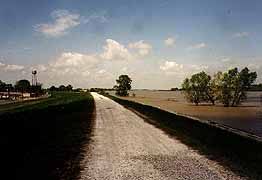
Catfish Country
|
By mid-afternoon Madame was toured out, and we left the river
at Plaquemine. My eyes were still smarting. Maybe from the big
refineries we’d been downwind of. The atmosphere along the lower
Mississippi is not salubrious. We couldn’t tell if all the supine
armadillos along the road, with their little claws in the air,
had been run down, or just passed out.
We quartered away from the big river by compass, cutting across
the Atchafalaya Basin. This was the South we’d imagined. Gigantic
old live oaks squatting beside the narrow roads, draped in moss.
Tin-clad shotgun shacks, or shallow hip-roofed houses with the
eaves almost to the ground. The buildings were all up on brick
piers, and I realize that this has been a defining detail throughout
the South, especially in low country. Keep your feet dry, I figured.
Along the bayous modest houses on barges were tied up under the
jungle growth, with skiffs knocking at the door.
Down these lanes I found one of my hypotheses shot full of holes.
Virtually no lawn ornaments! I’d expected the French regions to
be a paradise of signboard delight, like Quebec and Maine. There
were occasional concentrations of cement kitsch, certainly, but
you wouldn’t accuse the Cajuns of excess du dooryard, at least
not in Iberville or St. Landry Parishes.
Chastened, the Owlers blundered out of the undergrowth south of
Alexandria, and ran across yellow-flowered cattle country, and
through mile after mile of young cane. Sugar cane. Back in Mississippi
that park ranger had explained that the cane in “cane breaks”,
the impenetrable thickets that lined early American waterways,
was the wild bamboo we have seen everywhere in the South. These
grids of grassy sprouts, now knee-high, are the cutting kind of
cane, destined for candy bars, or the like. And cotton. Acres
of cotton. Those clusters of galvanized buildings called Lafourche
Gin, or Audnaud Gin, weren’t bottling plants, sonny. The tall
wire-mesh carts outside, with fluffy rags tangled in the sides,
were a dead give-away. This is still cotton country, too.
Punchy with anti-allergins, and stuffed full of plantation lore,
we found a working phone jack, returned to cyberspace, and slid
off into slumber.













